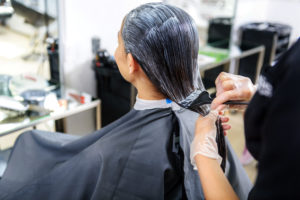Are you interested in a career in beauty? Want to be an expert in hair coloring and lightening? A career in Cosmetology may be perfect for you! After graduating from a diploma program in Cosmetology, you will need to pass the Cosmetology Licensure Examination administered by the Department of Business & Professional Regulations to work in the State of Florida.
Hair Coloring and Lightening
How prevalent is hair coloring and lightening? 75% of women dye their hair in some form whether at a salon or at home, according to Statistics Brain. 46% of women request highlighting and 35% of women request a full hair color change at salons. What does this mean? This means there is a need for cosmetologist to perform hair color and lightening treatments. Many cosmetologists will need to become familiar with the selection, preparation and application of many different types of hair coloring products and techniques. Before a client’s hair is colored, the cosmetologist should test the skin and patch of hair to ensure the desired effect before it is applied across the whole scalp and head of hair.
Skin Sensitivity Test / Strand Test – performed to understand how sensitive the skin is to hair dyes and other chemicals that are used to color and lighten hair. Take a patch of hair and test the dye or chemical first before applying to the entire head of hair to see how it reacts and whether it creates the desired effect.
There are a few different ways to color or lighten hair. A cosmetologist can use temporary hair color rinses or gels, semi-permanent color that causes less damage to the hair or permanent color that penetrates the cortex of the scalp to change the color of a client’s hair.
Temporary Color – available in many forms including rinses, shampoos, gels, sprays and foams. Temporary coloring products don’t penetrate the cortex of the hair. It coats the outside of the hair shaft with color that washes out during shampooing.
Semi-Permanent Color – doesn’t use developer, hydrogen peroxide or ammonia and causes less damage to the hair. Semi-permanent color is usually washed out after 4-5 shampoos.
Permanent Color – penetrates the cortex with the help of ammonia that opens up the cuticle layer of the scalp.
Permanent Toner – typically used to color hair that is either bleached or blonde to get rid of unwanted colors of orange or yellow.
Hair Lightener – a single-action tinting or tone of the hair to produce lighter looking hair.
Hair Special Effects – the use of color dyes, bleach and lighteners to create a desired effect in the hair including highlighting, frosting, streaking, hair painting, balayage, and tipping.
- Highlighting – a natural and discreet way to color the hair with shades that complement the current and natural hair color.
- Frosting – free-hand lightening the tips of the hair typically with bleach or a hair lightener.
- Streaking – visible and pronounced highlights in the hair used to illuminate the hair in contrast with its base color.
- Hair Painting – hair is painted free-hand in sections separated both on the top and bottom of the strand.
- Balayage – similar to hair painting, however only the surface of the strand is painted creating a built-in lowlight look.
- Tipping – the use of dye to color the tips of the hair.
Perform Root Retouch – the cosmetologist will use the same brand and color of hair dye to touch up the roots. A brush is used to apply the color to the roots.
Perform Corrective Color – used after a client drastically changes their hair color and corrective color is needed to remove the blotchy, faded or off-color look left on the hair.
There are a few ways for someone that has colored their hair to maintain their hair color. This can be done by using color-protecting shampoos and conditioners, using leave-in treatments with UV absorbents, and avoiding chlorine. Along with hair color, other parts of the face will need to be changed to match. The cosmetologist will need to learn how to tint eyelashes, eyebrows, beards and mustaches.
Tint Eyelashes and Eyebrows – used for those clients that don’t want to use mascara but still want a dark black look to the eyelashes and eyebrows. Mascara is known to flake, run and have a crusty look.
Tint Beards and Mustaches – used for men that want to get rid of the grey or that have blond facial hair that looks scruffy.
Color/Lighten Wigs or Hairpieces – If the wig or hairpiece is synthetic then it can’t accept permanent color. Coloring and lightening can only be done to natural hair wigs.
Are these hair coloring and hair lightening techniques interesting to you? Are you ready to earn your diploma in Cosmetology? Meridian College offers a Cosmetology training program in Florida that prepares you to deliver high-quality beauty and hair services to both men and women. Their hands-on Cosmetology training program gives you the skills you need to start an exciting career and become a leader in the beauty industry.
Contact Meridian College today to learn more about becoming a cosmetologist.